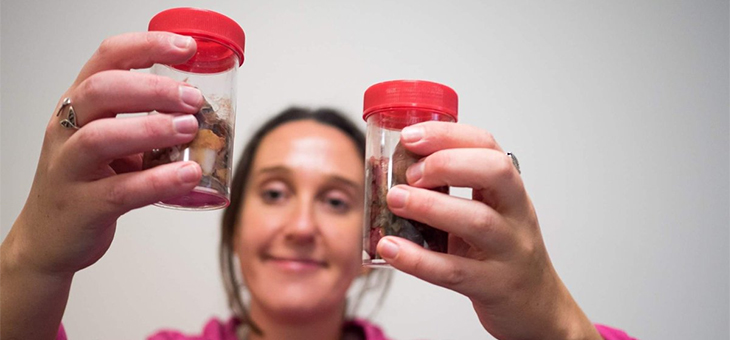How much plastic is in your seafood?

More than 35 per cent of fish caught in the waters off southern Australia contain microplastics, and the problem is most acute in South Australia, with plastic found in 49 per cent of fish, according to research from the University of Adelaide.
While Australian waters remain cleaner than many international fishing zones, lead researcher Nina Wootton found that many commercial and recreational fishers in the South Australian fishing industry weren’t aware that Australia even had an ocean plastic problem, in research published in Marine Policy this month.
“We wanted to find out what people knew about microplastic pollution in fish, from fishers to fishmongers to consumers,” Nina said. “It varied, but about half weren’t aware it was an issue because South Australian oceans had such a reputation for being clean.”
“We still have time to make sure Australian seafood products remain some of the cleanest in the world, but we need the seafood industry, and the general public, to recognise the problem and start taking positive actions now.”
The fishing industry can take a lead in solving the problem: previous studies estimate that 10% of plastic pollution in the ocean comes from fishing sources, so fishers can improve the quality of their own product by limiting their use of plastic where possible.
While fishers and other stakeholders were worried about the cost and inconvenience, simple actions like replacing plastic fishing equipment with natural materials, or using biodegradable bags at fish markets, could quickly reduce the amount of plastic ending up in the ocean. The researchers suggest an education program to raise awareness of the problem and provide solutions that the industry could implement easily to maintain the quality of locally caught fish.
Michael Violante, who has been part of the family-run fishmongers Seafood Works for nearly 25 years, said he was initially shocked by the findings.
“Fresh local seafood is a big part of my life, and to know that South Australia is not completely exempt from the plastic problem has got me thinking,” he said. “I am open to making changes to the way I use plastic and encourage others to do the same. From the fishers to the consumers, we all share this planet and can all do our small part to help lead the way to a cleaner and healthier ocean.”
The study shows the importance of bringing all stakeholders to the table to chart the way forward.
“We know that by bringing fishers into conversations around policy, we encourage the acceptance of new management ideas within the industry,” Nina said. “There is lots we can do to mitigate the problem of ocean plastic but we cannot begin unless people are aware there is a problem.”
This isn’t just a South Australian problem, or even an Australian one – about 75% of the fish we eat is imported from overseas. Future research could include a global audit of plastic in the fishing industry, and an evaluation of ways in which the industry can adopt new practices quickly and affordably.
Are you worried about the amount of plastic scientists are finding in our seafood?






Perhaps you've seen headlines saying we consume a credit card's worth of microplastics a week, or that microplastics have been found in our poo.
Now a new research paper has tried to identify the seafoods most likely to contribute microplastics — that is, plastic particles of between 1 micrometre and 5 millimetres — to the Australian diet.
Microplastics abound in the ocean and are often eaten by sea creatures, which means the particles could also make their way into our bodies when we consume seafood.
To work out the risk, researchers from the Australian Institute of Marine Science looked at previous studies of microplastics in seafood and compared it to Australians' eating habits.
They found Australians were most likely to ingest microplastics by eating bivalves, like oysters and mussels, and a smaller amount via crustaceans like prawns and crabs, although we don't consume as much of these foods as we might think
The main type of seafood eaten by Australians is fish fillets — and while microplastics are often found in fish guts, we generally don't eat that part of the animal.
Are microplastics actually bad for us?
When we talk about microplastics, there's usually an underlying assumption that they're inherently bad.
But while they are certainly not good for the environment and can cause harm to some animals, we actually don't know enough about what they do in human bodies to know whether or not they're unhealthy for us, environmental health scientist Kevin Thomas says.
"There are such major knowledge gaps that it's really hard at the moment to make a thorough assessment of whether there are any health risks from exposure to microplastics," said Professor Thomas, who is director of the Queensland Alliance for Environmental Health Sciences at the University of Queensland.
He says the tiniest microplastics, around 2.5 microns and smaller, are the ones most likely to do harm.
But because the term "microplastics" lumps everything from 5mm in size down, the data isn't there to know how widespread they are.
We also don't know what these tiny microplastics do inside the body.
Some studies that have looked directly at cells in the lab have found the particles can cause irritation and inflammation in the cells, but Professor Thomas says, "we don't know whether the plastics actually get into those cells in the first place to cause any inflammation-type effects".
Most microplastics probably move through the digestive system and come out in our poo, as earlier studies indicate.
But plastic is not as stable as you might think, and factors such as weathering, sun exposure and oxidising can all make chemical and structural changes that might affect how it interacts with our bodies.
So, just because we don't have the data to show that microplastics cause health problems doesn't mean they're safe; it just means we need to get the data, Professor Thomas says.
"Unless you understand where the plastic is coming from, what size it is, what particular plastic it is, and how it's been formed, it's really hard to understand whether it's going to pose any threat."